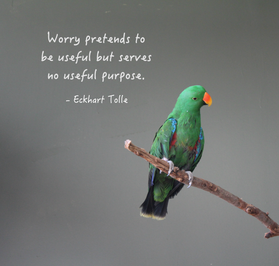 We all tend to have a habit to reacting when worry and anxiety ramp up in us. This article explores the differences between worry and anxiety, and offers a suggestion for being present with emotion in a new way. So what does worry, anxiety, fear, and panic have in common? Each state amps up our nervous system: awakening our senses and moving us into readiness for action – for our survival. Each state has a helpful side to it as well as a problematic side. Worry can encourage us to take action to change a situation. For example, a few years back I was worried that I wasn’t confident driving a car with standard transmission (which was all I had to drive at the time). I took a few extra driving lessons to gain experience and build confidence. The problematic side of worry however, shifts our thinking into a negative and catastrophic cycle. Focusing on themes that exacerbate a sense of helplessness, incongruence, and unpredictability can spiral us into anxiety. Worrying at this end of the continuum tends of focus on imagined future problems, which, by their very nature exceed our present-moment problem-solving abilities. In my example, had I focused on stalling the car while at an intersection, or rolling back down a hill, my worries would have shifted into anxiety and I might have found excuses to just not drive the car! The trouble with worrying is that it appears as though it should be helpful. After all, we are in a sense working through a problem from many different angels! As practical as that sounds, worrying does not help us find solutions to our problems, mainly because the focus of worry tends to center on problems that can not be solved with present-moment resources. “I’ve had a lot of worries in my life, most of which never happened” The anxiety reaction serves us well if we are presented with real-life danger and need to respond rapidly and effectively to the situation. It activates our body and our mind, putting us on high alert and causing us to scan for possible danger. Anxiety is always an attempt to stay safe – our bodies built-in survival mechanism. Anxiety becomes problematic when there is no real danger and the anxiety response goes off anyway. It becomes a problem when the intense felt-sense of anxiety and the cognitions of anxiety get in the way of our daily activities. The thoughts associated with anxiety most often focus on the future, which can lead to too many unresolved “what ifs”. These are problematic by nature because we can not foresee the future, and they have a tendency to lead us towards the negative. As we move into anxiety, subtle changes start to take place in the body as the nervous system moves into activation. The anxiety response serves us well if we are faced with real danger (flight/fight/freeze response). It is less helpful when the danger is imagined and we are trying to evaluate a future course of action: forecasting the worst-case scenario just leaves us feeling apprehensive and fearful.
Practice 1: Grounding Learning a new way to be with emotions can ben challenging. And just reading about it, or talking about it, doesn’t really help us learn how to do it. We have to actually learn to connect with the felt sense of emotion, and develop ways to settle the discomfort or fear that can arise when we do that. Try a guided breathing meditation, or a body scan to start fostering grounding skills. Then, when you notice moments of worry, try using the skill on your own. Practice 2: Noticing the Felt-Sense of Emotion Instead of running from worry, try focusing your attention on the way worry impacts you (for example, when you notice yourself worrying, what triggered it, how do your thoughts change, what sensations do you experience in your body, what is your typical response pattern for coping?). Once you have tuned in, use the grounding technique, and then prepare yourself to deal with the situation. Sometimes we need to pause and tune in so that we can respond to the situation with conscious intention. Practice 3: Linguistics Play a Role The words we use play a strong role in how we perceive our self, others, and the world around us. Our words have the power to impact our quality of life – some words can be destructive, and other words can be empowering. Over the next few days, tune in to the words you use. Do you use a lot of “I can’t”, or should, could, always, never, or other words that focus on pain, scarcity, or blame? If you catch yourself using them, try swapping them out for statements that are more empowering. For example:
References: McLaren, K (2010). The Language of Emotions: What your feelings are trying to tell you. Miller, K (2012). Mind-Body Attunement Therapy: Clinical Strategies
0 Comments
|
AuthorSusan Guttridge is a trauma-informed Master level Counsellor with the clinical designation of Canadian Certified Counsellor (CCPA). She has 20+ years experience providing individual and group therapy. Archives
January 2024
Categories
All
|

 RSS Feed
RSS Feed